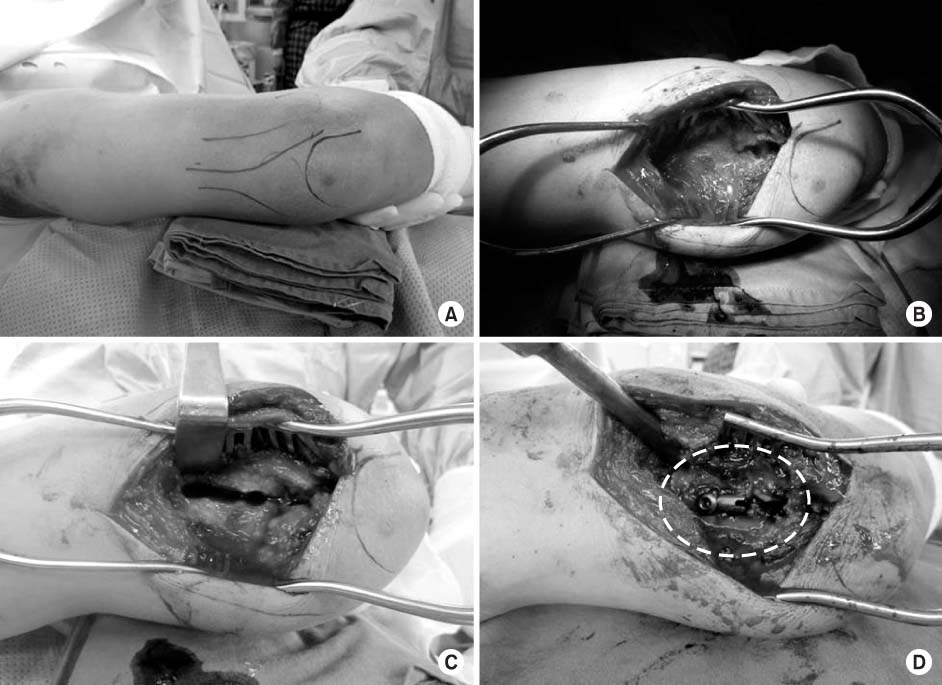J Korean Fract Soc.
2013 Oct;26(4):299-304. 10.12671/jkfs.2013.26.4.299.
Treatment of Humeral Shaft Fracture with Retrograde Intramedullary Nail
- Affiliations
-
- 1Department of Orthopedic Surgery, The Catholic University of Korea Yeouido St. Mary's Hospital, Seoul, Korea. sw.song@catholic.ac.kr
- 2Department of Orthopedic Surgery, The Catholic University of Korea St. Paul's Hospital, Seoul, Korea.
- KMID: 2183831
- DOI: http://doi.org/10.12671/jkfs.2013.26.4.299
Abstract
- PURPOSE
The purpose of this study was to report the outcome of treatment of humeral shaft fracture with retrograde intramedullary nail of advanced insertion opening.
MATERIALS AND METHODS
From April 2005 and August 2012, 22 patients with a humeral shaft fracture were treated by a single surgeon using the technique of retrograde intramedullary nail at Department of Orthopedic Surgery, Yeouido St. Mary's Hospital (Seoul, Korea). To avoid causing fractures at the insertion site, the entry point was more distally located than conventionally, and was extended proximally to include the proximal marginal cortex of the olecranon fossa. The outcome was evaluated clinically and radiologically.
RESULTS
The mean period of achievement of bony was 5.8 months (4-11 months). Additional fixations were needed in one patient with intraoperative lateral condylar fracture and 2 patients with postoperative nonunion. There were no limitations of movement or pain in the shoulder joint, and 8 cases had a 6.5degrees flexion contracture on average.
CONCLUSION
This retrograde intramedullary fixation technique using a distal entry portal near the olecranon fossa is particularly useful in humeral shaft fractures without a neurovascular injury. The risk of an intraoperative fracture (supracondylar fracture or fracture around the entry portal) can be decreased using this treatment. We recommend this technique because of the safety and the satisfactory outcome.
Figure
Reference
-
1. Barnes CE, Shuler TE. Complications associated with the Seidel nail. Orthop Rev. 1993; 22:699–706.2. Blum J, Janzing H, Gahr R, Langendorff HS, Rommens PM. Clinical performance of a new medullary humeral nail: antegrade versus retrograde insertion. J Orthop Trauma. 2001; 15:342–349.
Article3. Brumback RJ. The rationales of interlocking nailing of the femur, tibia, and humerus. Clin Orthop Relat Res. 1996; (324):292–320.
Article4. Cheng HR, Lin J. Prospective randomized comparative study of antegrade and retrograde locked nailing for middle humeral shaft fracture. J Trauma. 2008; 65:94–102.
Article5. Crates J, Whittle AP. Antegrade interlocking nailing of acute humeral shaft fractures. Clin Orthop Relat Res. 1998; (350):40–50.
Article6. Flinkkilä T, Hyvönen P, Lakovaara M, Linden T, Ristiniemi J, Hämäläinen M. Intramedullary nailing of humeral shaft fractures. A retrospective study of 126 cases. Acta Orthop Scand. 1999; 70:133–136.
Article7. Ingman AM, Waters DA. Locked intramedullary nailing of humeral shaft fractures. Implant design, surgical technique, and clinical results. J Bone Joint Surg Br. 1994; 76:23–29.
Article8. Klenerman L. Fractures of the shaft of the humerus. J Bone Joint Surg Br. 1966; 48:105–111.
Article9. Lin J. Treatment of humeral shaft fractures with humeral locked nail and comparison with plate fixation. J Trauma. 1998; 44:859–864.
Article10. Lin J, Hou SM. Locked nailing of severely comminuted or segmental humeral fractures. Clin Orthop Relat Res. 2003; (406):195–204.
Article11. McCormack RG, Brien D, Buckley RE, McKee MD, Powell J, Schemitsch EH. Fixation of fractures of the shaft of the humerus by dynamic compression plate or intramedullary nail. A prospective, randomised trial. J Bone Joint Surg Br. 2000; 82:336–339.12. Scheerlinck T, Handelberg F. Functional outcome after intramedullary nailing of humeral shaft fractures: comparison between retrograde Marchetti-Vicenzi and unreamed 4 AO antegrade nailing. J Trauma. 2002; 52:60–71.
Article13. Seidel H. Humeral locking nail: a preliminary report. Orthopedics. 1989; 12:219–226.
Article14. Zagorski JB, Latta LL, Zych GA, Finnieston AR. Diaphyseal fractures of the humerus. Treatment with prefabricated braces. J Bone Joint Surg Am. 1988; 70:607–610.
Article
- Full Text Links
- Actions
-
Cited
- CITED
-
- Close
- Share
- Similar articles
-
- Treatment of Humeral Shaft Fracture with Retrograde Flexible Nail
- Retrograde Intramedullary Nailing for Humerus Fracture in a Supine Position: Performing an Unfamiliar Procedure in a Familiar Position
- Polarus Intramedullary Nail for Proximal Humeral and Humeral Shaft Fractures in Elderly Patients with Osteoporosis
- Treatment of Humeral Shaft Fracture with AO Unreamed Humeral Nail
- Operative Treatment in Fractures of the Humeral Shaft: Comparison of the Clinical Results of Flexible Intramedullary Nailing Versus Interlocking Intramedullary Nailing



